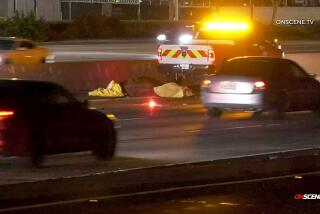Conductor’s Death Baffles His Colleagues
- Share via
State and federal investigators Monday were trying to determine why an experienced conductor mistakenly thought his train was going to collide with another locomotive and leaped to his death in Buena Park.
Train workers were mystified by the incident early Sunday and said they had never heard of such a thing.
“I’m flabbergasted,” said Bob Harvey, regulatory research coordinator for the Brotherhood of Locomotive Engineers in Washington, D.C. “I don’t understand.”
In the past, Harvey said, when crews had jumped, trains collided. “Our members have had to jump from trains at different times, believing in doing so they may be able to avoid certain death.”
The 6,000-foot-long train, with 65 cars and three engines, was running on one of Burlington Northern Santa Fe’s main lines, which carries 75 trains a day traveling east and west, company spokeswoman Lena Kent said. The train began its journey in Kansas City, Kan., and was heading to Los Angeles. The two-man crew boarded in Barstow at 7 p.m. Saturday.
Conductor Kevin Osher jumped from the westbound train Sunday about 2 a.m. because he thought it was going to crash into another train. The engineer, whose name has not been released, also thought the train was heading toward them. He started braking. Osher, 33, of Canoga Park, pulled the emergency brake, ran to the back of the engine and jumped into a dirt field on the right side of the train. The locomotive stopped about 850 feet in front of the other train on an adjacent track.
The eastbound train had been stopped for some time, detaching cars and adding others, Kent said.
She said train traffic signals had nothing to do with the tragedy. Warren Flatau, a spokesman for the Federal Railroad Administration, which is investigating the incident, said Osher’s train had passed a signal giving it the OK to proceed.
Kent said Osher, who had worked for the company for seven years, had traveled that route often and would have encountered trains on adjacent tracks many times, both stopped and moving in the opposite direction.
The Consumer Protection and Safety Division of the California Public Utilities Commission also are investigating the incident, along with the railroad.
Flatau said the investigation could take six months. The Orange County coroner’s office said toxicology tests on Osher will take about six weeks.
Federal rules require that the engineer be tested for drugs and alcohol after serious incidents, Flatau said.
Robin Doyno, a conductor and friend of Osher, doubted it was a factor in the incident.
“Let me be real clear: Alcohol and drugs are real rare at the railroad,” Doyno said.
Only one person was killed in a U.S. train accident in all of 2002, the lowest in the history of the industry, Flatau said.
Kent said investigators would check recordings of all radio conversations between dispatchers and the two men on the train, as well as review computer tapes tracking its speed. They also will probably investigate whether fatigue was a factor. Crews have said that irregular shifts and work rules can lead to a lack of sleep.
Although train experts were puzzled about how the Buena Park incident could have happened, some said it can be difficult to tell from a distance which track an oncoming train is traveling. They said much is based on trust.
“It would be just like you driving down the street and there is oncoming traffic on the other side of the yellow line,” Kent said.
Doyno, 59, who last spoke to Osher three weeks ago, said he was quiet and studious and had a good sense of humor. He said Osher enjoyed his job.
Doyno remembered taking him on a training run on a train filled with slaughtered animals. “It was one of the least palatable situations, and Kevin was joyous,” he said.
More to Read
Sign up for Essential California
The most important California stories and recommendations in your inbox every morning.
You may occasionally receive promotional content from the Los Angeles Times.













